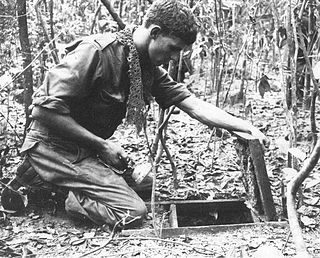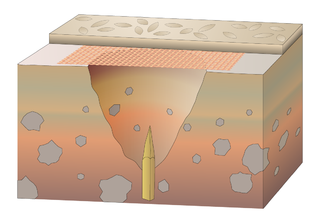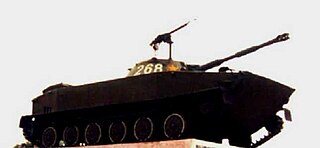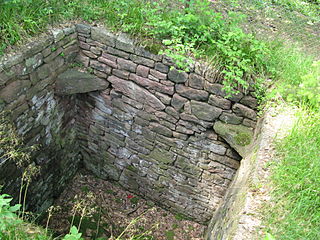
An ambush is a surprise attack carried out by people lying in wait in a concealed position. Ambushes as a basic fighting tactic of soldiers or of criminals have been used consistently throughout history, from ancient to modern warfare. In the 20th century, an ambush might involve thousands of soldiers on a large scale, or a small irregular band or insurgent group attacking a regular armed-force patrol. Theoretically, a single well-armed and concealed soldier could ambush other troops in a surprise attack. In recent centuries an ambush can involve the exclusive or combined use of improvised explosive devices that allow attackers to hit enemy convoys or patrols while minimizing the risk of being exposed to return fire.

A booby trap is a device or setup that is intended to kill, harm or surprise a human or another animal. It is triggered by the presence or actions of the victim and sometimes has some form of bait designed to lure the victim towards it. The trap may be set to act upon trespassers that enter restricted areas, and it can be triggered when the victim performs an action. It can also be triggered by vehicles driving along a road, as in the case of improvised explosive devices (IEDs).

The tunnel rats were American, Australian, New Zealander, and South Vietnamese soldiers who performed underground search and destroy missions during the Vietnam War.

In medieval fortification, a trou de loup was a type of booby trap or defensive obstacle. Each trou de loup consisted of a conical pit about 2 m deep and 1.2 to 2 m wide at the top. At the bottom of the pit, a sharpened punji stick would be hammered in. In some cases, the pit was concealed by light cover of wicker and a layer of soil.

The Battle of Lang Vei began on the evening of 6 February 1968 and concluded during the early hours of 7 February, in Quảng Trị Province, South Vietnam. Towards the end of 1967, the 198th Tank Battalion of the People's Army of Vietnam's (PAVN) 202nd Armored Regiment received instructions from the North Vietnamese Ministry of Defense to reinforce the 304th Division as part of the Route 9–Khe Sanh Campaign. After an arduous journey down the Ho Chi Minh trail in January 1968, the 198th Tank Battalion linked up with the 304th Division for an offensive along Highway 9, which stretched from the Laotian border through to Quảng Trị Province. On 23 January, the 24th Regiment attacked the small Laotian outpost at Bane Houei Sane, under the control of the Royal Laos Army BV-33 "Elephant" Battalion. In that battle, the 198th Tank Battalion failed to reach the battle on time because its crews struggled to navigate their tanks through the rough local terrain. However, as soon as the PT-76 tanks of the 198th Tank Battalion turned up at Bane Houei Sane, the Laotian soldiers and their families retreated into South Vietnam.

The 2nd Brigade Combat Team, 1st Cavalry Division is a cavalry unit of the United States Army based in Fort Cavazos, Texas.

The Battle of Ban Me Thuot was a decisive battle of the Vietnam War which led to the complete destruction of South Vietnam's II Corps Tactical Zone. The battle was part of a larger North Vietnamese military operation known as Campaign 275 to capture the Tay Nguyen region, known in the West as the Vietnamese Central Highlands.
The Battle of A Shau was waged in early 1966 during the Vietnam War between the People's Army of Vietnam (PAVN) and the forces of the United States and South Vietnam. The battle began on March 9 and lasted until March 10 with the fall of the U.S. Army's Special Forces camp of the same name. The battle was a strategic victory for the PAVN in that they were able to take control of the A Shau Valley and use it as a base area for the rest of the war.

Central Office for South Vietnam, officially known as the Central Executive Committee of the People's Revolutionary Party from 1962 until its dissolution in 1976, was the American term for the North Vietnamese political and military headquarters inside South Vietnam during the Vietnam War. It was envisaged as being in overall command of the communist effort in the southern half of the Republic of Vietnam, which included the efforts of both People's Army of Vietnam (PAVN), the Viet Cong, and the People's Revolutionary Party. Some doubted its existence but in his memoirs the American commander in South Vietnam, General William Westmoreland, spoke of it as something whose existence and importance were not in doubt.
During the Second Indochina War, better known as the Vietnam War, a distinctive land warfare strategy and organization was used by the National Liberation Front of South Vietnam (NLF) or better known as the Viet Cong (VC) in the West, and the People's Army of Vietnam (PAVN) or North Vietnamese Army (NVA) to defeat their American and South Vietnamese Army of the Republic of Vietnam (ARVN) opponents. These methods involved closely integrated political and military strategy – what was called dau tranh - literally "to struggle". The National Liberation Front, (NLF) was an umbrella of front groups, sympathizers and allies set up by the rulers of North Vietnam to conduct the insurgency in South Vietnam. The NLF also included fully armed formations- regional and local guerrillas, and the People's Liberation Armed Forces (PLAF). The PLAF was the "Main Force" – the Chu Luc or full-time soldiers of the NLF's military wing. Many histories lump both the NLF and the armed formations under the term "Viet Cong" or "VC" in common usage. Both were tightly interwoven and were in turn controlled by the North. Others consider the Viet Cong, or "VC" to primarily refer to the armed elements. The term PAVN, identifies regular troops of the North Vietnamese Army or NVA as they were commonly known by their Western opponents. Collectively, both forces- the southern armed wing and the regulars from the north were part of PAVN.

The Battle of Kham Duc was a major battle of the Vietnam War. The event occurred in Khâm Đức, now district capital of Khâm Đức District, then in Quảng Tín Province, from 10–12 May 1968. During the Tet Offensive of 1968, the People's Army of Vietnam (PAVN) 2nd Division tried to capture Đà Nẵng, but they were defeated in the Battle of Lo Giang by elements of the U.S. 1st Marine Division and the 23rd Infantry Division. PAVN General Chu Huy Mân disengaged from the fight on the outskirts of the city, and pulled the 2nd Division into the mountains to rest, rebuild, and prepare for the next major operation. The US and allied defenders of the Special Forces camp at Khâm Đức, a small district in the north of Quảng Tín, were chosen as the next target for the 2nd Division. Although the Special Forces camp had never been an obstacle to the constant infiltration of PAVN troops around it, the North Vietnamese hoped to attract major US reinforcements away from the lowland populated areas, kill or capture them and film the battle, presumably to make it look like a US Điện Biên Phủ on the eve of the 1st Paris peace conference.

Trapping pits are deep pits dug into the ground, or built from stone, in order to trap animals. European rock drawings and cave paintings reveal that red deer and elk/moose were hunted since the Stone Age using trapping pits. Remains of trapping pits used for hunting elk, reindeer, wolves, and bears can still be found in Northern Scandinavia. These pits, which can measure up to 4 by 7 metres in size and be up to several metres deep, were camouflaged with branches and leaves. They had steep sides lined with planks or masonry, making it impossible for the animal to escape once it had fallen in. When the animal had fallen into the pit, it was killed, either bled to death by sharpened sticks pointed upwards from the bottom of the pit, or in the case of pits without these sticks, dispatched by hunters waiting nearby. Some traps had a small rope enabling rodents and amphibians to escape.

The First Battle of Quảng Trị resulted in the first major victory for the People's Army of Vietnam (PAVN) during the Easter Offensive of 1972. Quảng Trị Province was a major battleground for the opposing forces during the Vietnam War. As South Vietnamese soldiers were gradually replacing their American counterparts, North Vietnam's General Văn Tiến Dũng was preparing to engage three of his divisions in the province. Just months before the battle, the Army of the Republic of Vietnam (ARVN) deployed its newly formed 3rd Division to the areas along the Vietnamese Demilitarized Zone (DMZ) to take over former US bases. North Vietnamese forces deployed against the inexperienced ARVN 3rd Division included the PAVN 304th, 308th and 324B Divisions.

The Viet Cong and the North Vietnamese People's Army of Vietnam (PAVN) used well-organized logistics methods to supply and equip their fighting forces. This logistics organization helped greatly in their war against the American and South Vietnamese military during the Vietnam War.

VC and PAVN battle tactics comprised a flexible mix of guerrilla and conventional warfare battle tactics used by Viet Cong (VC) and the North Vietnamese People's Army of Vietnam (PAVN) to defeat their U.S. and South Vietnamese (GVN/ARVN) opponents during the Vietnam War.
A cartridge trap is a type of booby trap devised by the Viet Cong and subsequently used against American and other anti-Communist forces supporting South Vietnam during the Vietnam War. It derives its name from the fact that the wounding component of the trap is a small arms cartridge.
Fire Force or Fireforce is a variant of the military tactic of vertical envelopment of a target by helicopter-borne and parachute infantry developed by the Rhodesian Security Forces during the Rhodesian Bush War. Regiments involved included the Rhodesian Light Infantry (RLI), the Rhodesian African Rifles (RAR) and the Rhodesian Special Air Service (SAS) assisted by the Rhodesian Air Force (RhAF). The Fire Force counterinsurgency missions were designed to trap and eliminate Zimbabwe African National Liberation Army (ZANLA) and Zimbabwe People's Revolutionary Army (ZIPRA) insurgents before they could flee.

Operation Paul Revere IV was a United States Army operation of the Vietnam War that took place in the Plei Trap Valley, lasting from 20 October to 30 December 1966.

The Liberation Army of South Vietnam was an irregular military force established by the Workers' Party of Vietnam in 1961 in South Vietnam as the armed wing of the Viet Cong. In 1962, the People's Revolutionary Party of South Vietnam separated from the Workers' Party of Vietnam in terms of external appearance, openly directing the Liberation Army's military. Politically, the South Vietnamese Liberation Army was under the direction of the National Front for the Liberation of South Vietnam and the Provisional Revolutionary Government of the Republic of South Vietnam. The military forces from the North to the South of Vietnam, although collectively known as the Liberation Army of South Vietnam, still use the unit names, military badges and War flag of the Vietnam People's Army.

The Battle of the Slopes was the site of an engagement between elements of the 173rd Airborne Brigade (Separate), nicknamed "Westmoreland's Fire Brigade" and People's Army of Vietnam (PAVN) units, as part of Operation Greeley.
















